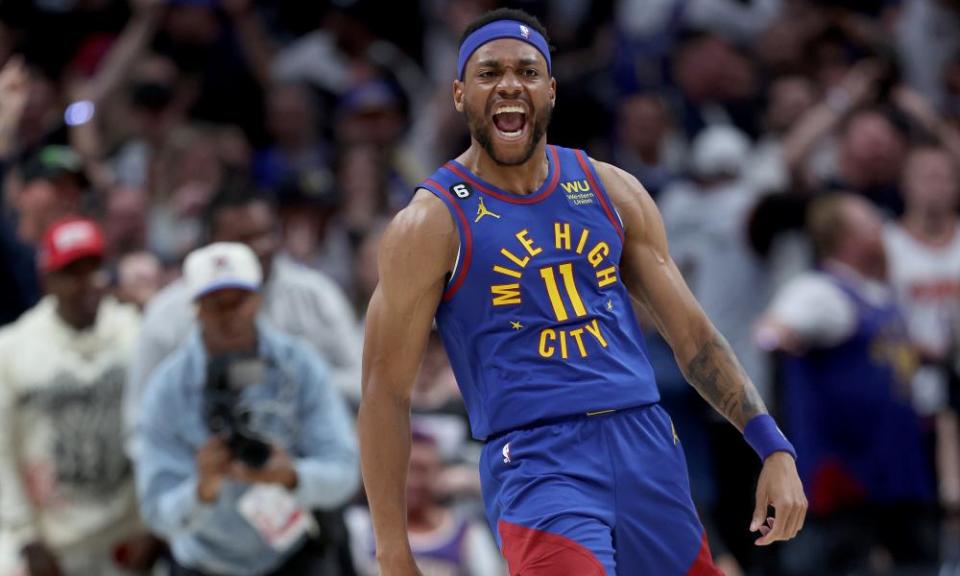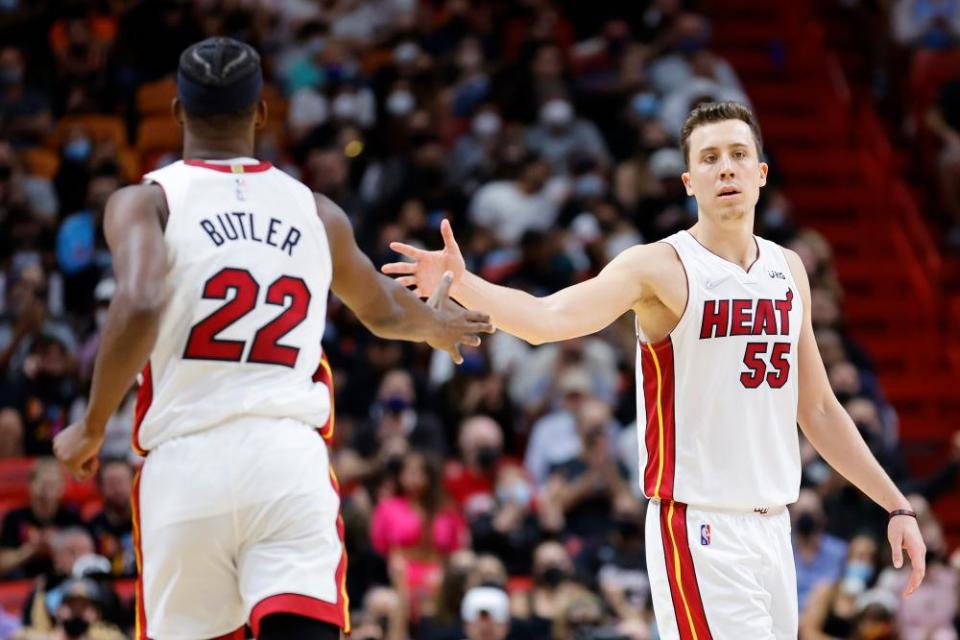‘Always be in the ballgame’: how bench players can tilt the NBA finals

Before the 1982 NBA finals against the Los Angeles Lakers, Earl Cureton had no idea when he might play in the series. But instead of focusing on what he didn’t know, the backup forward-center for the Julius Erving-led Philadelphia 76ers focused on what he could. Stay ready, observe the game. Don’t lose sight of how to help, even in small doses. It doesn’t matter that you’re a reserve on the sidelines, Cureton told himself. Still, the experience was jarring; his first time in the league’s final series. The playoffs are a different animal compared to the regular season and the NBA finals are even more pressurized. Though this all swirled in Cureton’s mind some 40 years ago, the task remains the same for players today. Indeed, in this year’s NBA finals, players like Denver’s Bruce Brown Jr and Miami’s Duncan Robinson will undertake crucial roles coming off the bench for their squads. But what exactly does it take to excel as a backup in the league – especially in June?
“Your mental focus is the most important thing you have to sharpen when it comes to the playoffs,” Cureton tells the Guardian. “With my situation [in Philly], I never knew when I was going in. And you never know what’s going to happen – foul trouble, injuries. You have to prepare yourself like you’re going to be out there every single game.”
During the course of his career, the Detroit-born Cureton played in 54 playoff games (he started in four) with three different teams. During the regular season, Cureton started 137 games and played in a total of 674 on rosters with the likes of Michael Jordan, Isiah Thomas and Muggsy Bogues. But Cureton says he approached NBA finals games like any other. The same pregame routine, the same warmups. The same research on opposing players and team strategies. And when the games began, he dutifully watched from the bench, noticing what the starters did in order to discern what he could emulate and what he could do differently. In 1982, his 76ers eventually lost to the Lakers in the finals. But the next year, Philadelphia, led by Erving and the newly acquired Moses Malone swept Los Angeles, earning Cureton his first ring.
“I watched Moses to see how he was guarding Kareem [Abdul-Jabbar],” says Cureton. “I’d watch for how I could have an advantage against him. You got to have a feel. You’ve got to be in the ballgame when sitting on the bench.”
Cureton’s team went to the NBA finals in back-to-back seasons thanks to a combination of big names like Dr J, Malone, Darryl Dawkins and Andrew Toney, and backup players like Bobby Jones and Clint Richardson. But in ‘82, Cureton played a big reserve role, matching up against Abdul-Jabbar, even stripping the ball from the All-Star several times. In ‘83, the team had acquired Malone in the offseason and Cureton played less. Still, though, in Game 2 of the ‘83 finals, he had his biggest highlight. Malone was subbed out, in foul trouble. And Cureton had to help keep the contest afloat. The 76ers were up in the series 1-0, but against the Lakers one mistake could be fatal. At one point, Cureton found himself near the basket, with Abdul-Jabbar on his back. Cureton got the ball, spun and shot a hook over the guy who made the move famous, sinking it. Instead of the 76ers folding without Malone, the team increased its lead thanks in part to the ever-ready Cureton. Philadelphia went on to sweep the Lakers.
“It was a big moment,” Cureton says of the shot.
Eleven years later, the reserve big man found himself again in the NBA finals. This time with the Houston Rockets, led by Hakeem Olajuwon. Cureton had signed just a few days before the end of the 1993-94 regular season, barely in time to make the playoff roster. He’d actually put pen to the contract paper from the bench in his first game. And in the postseason, the 37-year-old veteran was thrust into an expanded role on the team. The Rockets’ spry young forward Carl Herrera went down with injury and Cureton had to play more minutes. He quickly became a vital part of the rotation, backing up Olajuwon and Otis Thorpe. And when Herrera came back for the finals against the New York Knicks, Cureton gave back his spot. “I did my job,” he says of the moment, the maxim of the consummate bench role player.
“That’s all part of winning a championship,” says Cureton, who went on to coach in the CBA and WNBA after he retired. “You got guys who step up for the moment. It’s all about the moment. If you rise to it, the fans will never forget. If you do it in the playoffs, it’s etched in stone. If you do it in the finals, that’s history.”
Denver’s sharpshooting small forward, starter Michael Porter Jr, agrees. Speaking during a recent media availability ahead of this year’s finals, Porter Jr praised the Nuggets’ first-year general manger, Calvin Booth, and the mix of starters and role players he brought onto the roster. Team building, says Porter Jr, is paramount. And that means bench players and chemistry must be prized by the decision-makers.
“The guys [Booth] brought in are a huge part of the reason why we’re in the finals,” Porter Jr said. “Obviously [Kentavious Caldwell-Pope] and Bruce [Brown] being two of those guys. But really the vets, too. As much as the guys on the floor are contributing to us winning, guys like [DeAndre Jordan], Jeff [Green], Ish [Smith], Reggie [Jackson] – those guys’ attitude and their leadership is part of the reason why we’re doing so well. It’s really just finding a group of dudes that mesh in the locker room is a big part of winning.”
For more evidence, look no further than the ‘Rip City’ Portland Trailblazers. The franchise’s sole championship came in 1977 with their hippie center, Bill Walton. And the title remains beloved by the area, cherished like a family heirloom. Starting point guard Lionel Hollins was another one of the stars on the roster that year, averaging 17.3 points in 19 games in the playoffs. But while Hollins knows what it takes to win a finals ring from start to finish, he also knows what it feels like to come up shy of the goal. In 1978, the Blazers lost just 11 games by 7 March, but then Walton went down with a foot injury and so did the team’s hopes to repeat. Later, in his second career in the league, as a head coach, Hollins took the “grit-and-grind” Memphis Grizzlies to the Western Conference finals in 2013, losing to the San Antonio Spurs. Hollins, now an assistant in Houston, also won a ring in 2020 as a coach for the Lakers in the NBA bubble.
“The two most important things for a bench player, especially in the playoffs,” says Hollins, “is to embrace the role and stay focused while watching the game”.

Hollins recommends that when the matchup begins, bench players figure out from their seats how they can contribute, both offensively and defensively. He knows there is a great deal of excitement when a game starts, and it can be something of a letdown to go to the bench at tip-off. But vigilance is paramount for success. Some guys, he says, if they aren’t starting, tend to kick back at the beginning of a game, forgetting the job at hand. Suddenly, when their number is called, they’re not prepared, and the team suffers. Those who do pay close attention, however, Hollins says, understand the rhythm of the game and how to work with it or mix it up. Those are the ones who succeed.
“Players coming off the bench have to be the ones who alter the course of the game and momentum when they go in, in a positive way,” says Hollins.
In the playoffs, coaches tend to call on fewer players, shrinking rotations. So, a substitute will also have to be ready to play against higher-quality opponents. In a do-or-die game, seven players on a given roster might get used. It’s the cream of the crop. Hollins remembers the days leading up to the ’77 finals, conversations he had with teammates about playing their best. To know their opponents’ every move. Even still, it took Portland several games to adjust to the fishbowl-like atmosphere. Philly, led by Dr J who had just arrived in the NBA from the ABA, won the first two games in the series. But Portland’s defensive strategy took hold, and they swept the next four, winning the series 4-2. There is so much “hype” heading into the finals, says Hollins, it can be hard to take the necessary breath, no matter who you are. As a fallback, a player must trust the plan, their role.
“[Coach] Jack Ramsay had a meeting with me,” Hollins remembers. “He just said, ‘Your offense is not going to win the game for us. It’s going to be your defense. We had a plan how to slow down [the Lakers] – pressure them full court.”
Hollins says communication is crucial as a coach. Everyone wants to be the star – to shoot and score and get the glory. But most of the players on a roster, especially those on the bench, have to be specialists, ready at a moment’s notice to fill the necessary, designated assignment. If a player is able to, say, come into a game and lock someone down on defense, it can make all the difference. And just as every player is looking for an advantage, so is every coach and front office. Rosters must be shaped and refined for the hard job ahead.
“You’re always looking at needs,” Hollins says. “Every team has weaknesses.”
To wit, the coach recalls quick guard Jerryd Bayless. He had come to the Grizzlies during the team’s stellar 2012-13 season in which the franchise went 56-26. A college star with Arizona, Bayless had played for Portland, New Orleans and Toronto prior to Memphis. He hadn’t quite found his role in the league yet. Teams saw him as a backup playmaker, someone meant to set up others. But Hollins and Memphis saw him as a skilled scorer off the bench. So they unleashed him that way and Bayless enjoyed arguably his best year, playing in 80 games (a career high) and averaging 8.7 points, 3.3 assists and 2.2 rebounds in 22.1 minutes. That story reminds Hollins of another – of small-forward Corky Calhoun. Before the 1976-77 championship year, Portland picked up the athletic front court player to bolster their bench after Calhoun had been waived by the Lakers. It was a perfect fit for a title run.
“We signed him, and he was a huge factor in the finals against Doc,” Hollins says. “Doc still averaged 40 points per game, or something to that level. But between Corky and Bobby Gross, they made him have to work.”

 Yahoo Sport
Yahoo Sport 





































